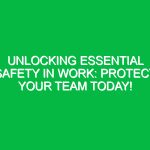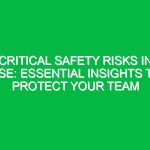Introduction
Hello team! Today, we’re here for our Toolbox Talk, and our focus is on a critical health issue that affects many workers across various industries: Silicosis. As you may know, this is a serious lung disease caused by inhaling fine silica dust, which can be found in materials we often work with, such as sand, rock, and concrete. Understanding Silicosis is essential for ensuring our Safety and health on the job. By the end of this talk, you’ll be equipped with the knowledge and tools to recognize the risks associated with Silicosis and implement strategies to protect yourself and your colleagues.
What is Silicosis?
Silicosis is a type of pneumoconiosis, a disease that occurs from inhalation of various types of dust. It specifically develops after long-term exposure to crystalline silica dust. When the dust enters the lungs, it causes inflammation and scarring, leading to symptoms that can severely impact your health and wellbeing. The disease may take years to develop, but the Effects can be irreversible and life-threatening.
Types of Silicosis
There are three primary types of Silicosis, which differ based on the duration and level of exposure:
- Chronic Silicosis: This is the most common form and occurs after 10 or more years of low to moderate exposure.
- Accelerated Silicosis: This type develops after 5 to 10 years of high-level exposure.
- Acute Silicosis: This is a rare form that can occur after very high exposure over a short period, leading to severe symptoms within weeks or months.
Why is Silicosis a Concern in the Workplace?
Understanding the impact of Silicosis is vital for all of us, especially in the Health, Safety, and Environment (HSE) domain. Here are some reasons why we must pay close attention:
- Health Risks: Silicosis can lead to serious health complications, including chronic obstructive pulmonary disease (COPD), lung cancer, and even respiratory failure.
- Legal and Regulatory Compliance: Many countries have strict Regulations regarding silica exposure in the workplace. Failing to comply can lead to legal repercussions for both individuals and the company.
- Workplace Safety: Understanding and mitigating the risks associated with Silicosis helps create a safer work environment, reducing accidents and health issues.
- Cost Implications: Health complications from Silicosis can lead to increased healthcare costs, lost productivity, and potential compensation claims.
Recognizing the Signs and Symptoms
Being aware of the signs and symptoms of Silicosis is crucial. Early detection can lead to better management of the disease. Common symptoms include:
- Coughing, often persistent or chronic
- Shortness of breath, especially during physical activities
- Chest pain or tightness
- Fatigue and weakness
- Fever and night sweats (in advanced cases)
If you experience any of these symptoms, it’s essential to report them to your supervisor and seek medical attention promptly.
Potential Hazards and Risks Associated with Silicosis
In our daily operations, there are specific activities and materials that pose a higher risk of silica exposure. Here are some common scenarios:
- Working with Sandblasting equipment
- Drilling or cutting concrete, brick, or stone
- Mining or working in environments with high silica dust
- Handling materials that contain crystalline silica, such as certain types of glass and ceramics
Best Practices to Prevent Silicosis
Now that we understand the risks, let’s discuss some Best Practices to prevent Silicosis in our workplace:
- Personal Protective Equipment (PPE): Always wear appropriate PPE, such as respirators, masks, and dust goggles, when working in dusty environments.
- Engineering Controls: Use tools and equipment that minimize dust generation. For example, water suppression systems can be effective in controlling dust during cutting and drilling.
- Work Practices: Implement safe work practices, such as using wet methods to suppress dust and ensuring proper ventilation in enclosed spaces.
- Regular Monitoring: Participate in regular air quality monitoring and health screenings to detect any signs of exposure early.
- Training and Awareness: Attend Training sessions on Silicosis and stay informed about the risks and Prevention strategies.
Real-Life Example: A Case Study
Let’s consider a hypothetical scenario to illustrate the importance of understanding Silicosis. Imagine a construction site where workers are frequently cutting concrete without using water to suppress the dust. Over time, several workers begin to experience persistent coughs and shortness of breath. After a routine health screening, it’s discovered that they are showing early signs of Silicosis.
If proper dust Control Measures and training had been implemented from the start, this situation could have been avoided. This example underscores the necessity of adhering to safety protocols and being proactive in recognizing the risks associated with Silicosis.
Regulations and Standards
It’s essential to be aware of the regulations regarding silica exposure. In many jurisdictions, workplace exposure limits for crystalline silica are defined by law. For instance, the Occupational Safety and Health Administration (OSHA) in the United States has set permissible exposure limits (PEL) for silica dust. Compliance with these regulations is not just a legal obligation, but it also plays a crucial role in maintaining a safe workplace.
Company Policies on Silicosis
Our company has established specific policies to address the risks associated with Silicosis. These include:
- Mandatory training sessions on silica exposure and prevention
- Regular health check-ups and screenings for employees exposed to silica
- Implementation of engineering controls and proper ventilation systems
- Strict adherence to PPE guidelines
Being familiar with these policies is essential for all employees. Compliance not only ensures your safety but also contributes to the overall well-being of our work environment.
Conclusion
In conclusion, understanding Silicosis and its implications is vital for all of us. By recognizing the risks and implementing effective preventative measures, we can protect ourselves and our colleagues from this serious health issue. I urge each of you to take this information seriously and apply it in your daily activities.
Thank you for your attention and commitment to safety. Let’s continue to work together to maintain a safe and healthy workplace. If you have any questions or concerns regarding Silicosis or any other health and safety issues, please don’t hesitate to speak up!


